The fibroblast integrin alpha11beta1 is induced in a mechanosensitive manner involving activin A and regulates myofibroblast differentiation
- PMID: 20129924
- PMCID: PMC2856250
- DOI: 10.1074/jbc.M109.078766
The fibroblast integrin alpha11beta1 is induced in a mechanosensitive manner involving activin A and regulates myofibroblast differentiation
Abstract
Fibrotic tissue is characterized by an overabundance of myofibroblasts. Thus, understanding the factors that induce myofibroblast differentiation is paramount to preventing fibrotic healing. Previous studies have shown that mechanical stress derived from the integrin-mediated interaction between extracellular matrix and the cytoskeleton promotes myofibroblast differentiation. Integrin alpha11beta1 is a collagen receptor on fibroblasts. To determine whether alpha11beta1 can act as a mechanosensor to promote the myofibroblast phenotype, mouse embryonic fibroblasts and human corneal fibroblasts were utilized. We found that alpha11 mRNA and protein levels were up-regulated in mouse embryonic fibroblasts grown in attached three-dimensional collagen gels and conversely down-regulated in cells grown in floating gels. alpha11 up-regulation could be prevented by manually detaching the collagen gels or by cytochalasin D treatment. Furthermore, SB-431542, an inhibitor of signaling via ALK4, ALK5, and ALK7, prevented the up-regulation of alpha11 and the concomitant phosphorylation of Smad3 under attached conditions. In attached gels, TGF-beta1 was secreted in its inactive form but surprisingly not further activated, thus not influencing alpha11 regulation. However, inhibition of activin A attenuated the up-regulation of alpha11. To determine the role of alpha11 in myofibroblast differentiation, human corneal fibroblasts were transfected with small interfering RNA to alpha11, which decreased alpha-smooth muscle actin expression and myofibroblast differentiation. Our data suggest that alpha11beta1 is regulated by cell/matrix stress involving activin A and Smad3 and that alpha11beta1 regulates myofibroblast differentiation.
Figures
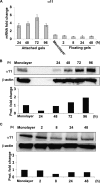
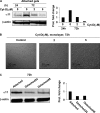
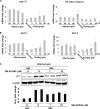
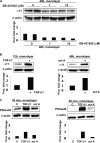
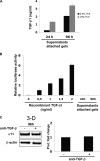
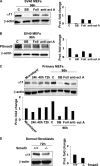
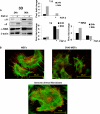
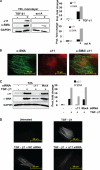
Similar articles
-
The mesenchymal alpha11beta1 integrin attenuates PDGF-BB-stimulated chemotaxis of embryonic fibroblasts on collagens.Dev Biol. 2004 Jun 15;270(2):427-42. doi: 10.1016/j.ydbio.2004.03.006. Dev Biol. 2004. PMID: 15183724
-
Glycated Collagen Induces α11 Integrin Expression Through TGF-β2 and Smad3.J Cell Physiol. 2015 Feb;230(2):327-36. doi: 10.1002/jcp.24708. J Cell Physiol. 2015. PMID: 24962729
-
Fibroblast α11β1 integrin regulates tensional homeostasis in fibroblast/A549 carcinoma heterospheroids.PLoS One. 2014 Jul 30;9(7):e103173. doi: 10.1371/journal.pone.0103173. eCollection 2014. PLoS One. 2014. PMID: 25076207 Free PMC article.
-
Integrin α11β1: a major collagen receptor on fibroblastic cells.Adv Exp Med Biol. 2014;819:73-83. doi: 10.1007/978-94-017-9153-3_5. Adv Exp Med Biol. 2014. PMID: 25023168 Review.
-
New Therapeutic Targets for Hepatic Fibrosis in the Integrin Family, α8β1 and α11β1, Induced Specifically on Activated Stellate Cells.Int J Mol Sci. 2021 Nov 26;22(23):12794. doi: 10.3390/ijms222312794. Int J Mol Sci. 2021. PMID: 34884600 Free PMC article. Review.
Cited by
-
Integrin α11 in non-small cell lung cancer is associated with tumor progression and postoperative recurrence.Cancer Sci. 2020 Jan;111(1):200-208. doi: 10.1111/cas.14257. Epub 2019 Dec 18. Cancer Sci. 2020. PMID: 31778288 Free PMC article.
-
Interstitial lung disease in Systemic sclerosis: insights into pathogenesis and evolving therapies.Mediterr J Rheumatol. 2018 Sep 27;29(3):140-147. doi: 10.31138/mjr.29.3.140. eCollection 2018 Sep. Mediterr J Rheumatol. 2018. PMID: 32185315 Free PMC article. Review.
-
The Role of NADPH Oxidases (NOXs) in Liver Fibrosis and the Activation of Myofibroblasts.Front Physiol. 2016 Feb 2;7:17. doi: 10.3389/fphys.2016.00017. eCollection 2016. Front Physiol. 2016. PMID: 26869935 Free PMC article. Review.
-
Fibroblast Growth Factor 2 as an Antifibrotic: Antagonism of Myofibroblast Differentiation and Suppression of Pro-Fibrotic Gene Expression.Cytokine Growth Factor Rev. 2017 Dec;38:49-58. doi: 10.1016/j.cytogfr.2017.09.003. Epub 2017 Sep 23. Cytokine Growth Factor Rev. 2017. PMID: 28967471 Free PMC article. Review.
-
Generation of a novel mouse strain with fibroblast-specific expression of Cre recombinase.Matrix Biol Plus. 2020 Jul 7;8:100045. doi: 10.1016/j.mbplus.2020.100045. eCollection 2020 Nov. Matrix Biol Plus. 2020. PMID: 33543038 Free PMC article.
References
Publication types
MeSH terms
Substances
LinkOut - more resources
Full Text Sources
Other Literature Sources

